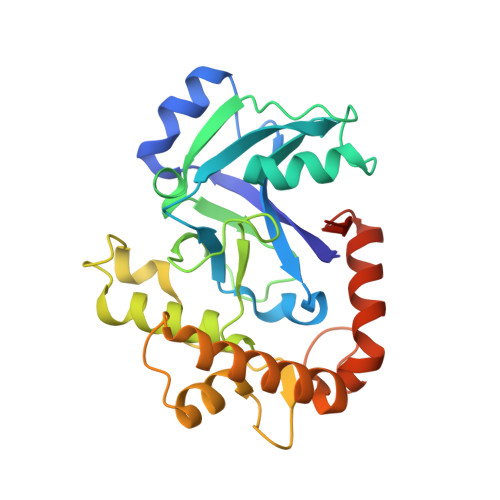Analysis of the Resistance Mechanism of a Benzoxaborole Inhibitor Reveals Insight Into the Leucyl-tRNA Synthetase Editing Mechanism.
Zhao, H., Palencia, A., Seiradake, E., Ghaemi, Z., Cusack, S., Luthey-Schulten, Z., Martinis, S.(2015) ACS Chem Biol 10: 2277
- PubMed: 26172575
- DOI: https://doi.org/10.1021/acschembio.5b00291
- Primary Citation of Related Structures:
5AGH, 5AGI, 5AGJ - PubMed Abstract:
A new class of antimicrobial benzoxaborole compounds was identified as a potent inhibitor of leucyl-tRNA synthetase (LeuRS) and therefore of protein synthesis. In a novel mechanism, AN2690 (5-fluoro-1,3-dihydro-1-hydroxy-2,1-benzoxaborole) blocks fungal cytoplasmic LeuRS by covalently trapping tRNA(Leu) in the editing site of the enzyme's CP1 domain. However, some resistant mutation sites are located outside of the CP1 hydrolytic editing active site. Thus, their mode of action that undermines drug inhibition was not understood. A combination of X-ray crystallography, molecular dynamics, metadynamics, biochemical experiments, and mutational analysis of a distal benzoxaborole-resistant mutant uncovered a eukaryote-specific tyrosine "switch" that is critical to tRNA-dependent post-transfer editing. The tyrosine "switch" has three states that shift between interactions with a lysine and the 3'-hydroxyl of the tRNA terminus, to inhibit or promote post-transfer editing. The oxaborole's mechanism of action capitalizes upon one of these editing active site states. This tunable editing mechanism in eukaryotic and archaeal LeuRSs is proposed to facilitate precise quality control of aminoacylation fidelity. These mechanistic distinctions could also be capitalized upon for development of the benzoxaboroles as a broad spectrum antibacterial.
- European Molecular Biology Laboratory, Grenoble Outstation and Unit of Virus Host-Cell Interactions, UJF-EMBL-CNRS, UMI 3265 , 71 Avenue des Martyrs, BP181, 38042 Grenoble Cedex 9, France.
Organizational Affiliation:

















